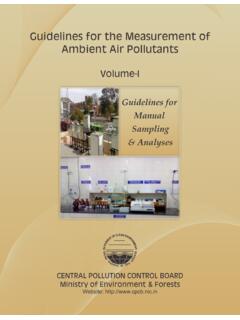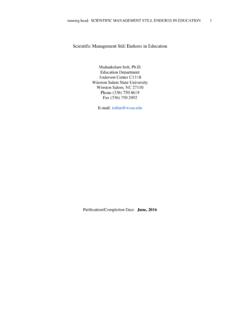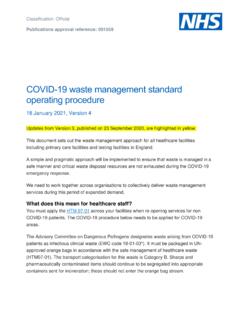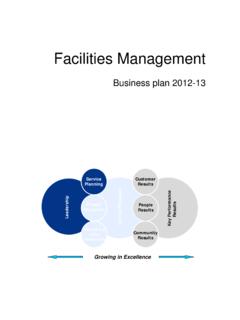Transcription of Municipal Solid Waste Management
1 1 Municipal Solid Waste Management Introduction Civilization began & developed around river banks. Things were manageable at those times as people lived in harmony with nature. Industrialization changed everything. At the end of the 19th century the industrial revolution saw the rise of the world of consumers. Concentrated population packets developed at and around industrial area. Rapid Urbanization process posed many challenges before planning authorities. Government, local administration tried & is trying their level best to provide all basic amenities to this population. While doing so, one difficult challenge before administration is to manage Waste generated by this large population. Solid Waste generation is a continually growing problem at global, regional and local levels. Solid wastes are those organic and inorganic Waste materials produced by various activities of the society, which have lost their value to the first user.
2 Improper disposal of Solid wastes pollutes all the vital components of the living environment ( , air, land and water) at local and global levels. The problem is more acute in developing nations than in developed nations, as their economic growth as well as urbanization is more rapid. There has been a significant increase in MSW ( Municipal Solid Waste ) generation in India in the last few decades. This is largely because of rapid population growth and economic development in the country. Due to rapid growth of urban population, as well as constraint in resources, the Management of Solid Waste poses a difficult and complex problem for the society and its improper Management gravely affects the public health and degrades environment. The population of Mumbai grew from around million in 1981 to million in 1991, registering a growth of around 49%.
3 On the other hand, MSW generated in the city increased from 3200 tonnes per day to 5355 tonnes per day in the same period registering a growth of around 67% (CPCB 2000). This clearly indicates that the growth in MSW in our urban centers has outpaced the population growth in recent years. This trend can be ascribed to our changing lifestyles, food habits, and change in living standards. Waste referred as rubbish, trash, garbage, or junk is unwanted or unusable material. According to European councils directive Waste is any substance or object which the holder discards or intends or is required to discard." Waste if it is hazardous or toxic, it could even be a harbinger of disease and death, not just for living beings, but for all that sustains life, for example, water, air, soil and food. Solid Waste can be defined as any Solid or semi- Solid substance or object resulting from human or animal activities, discarded as useless or unwanted.
4 It is an extremely mixed mass of wastes, which may originate from household, commercial, industrial or agricultural activities. Solid Waste is a broad term, which encompasses all kinds of Waste such as Municipal Solid Waste (MSW), Industrial Waste (IW), Hazardous Waste (HW), Bio-Medical Waste (BMW) and Electronic Waste (E- Waste ) depending on their source & composition. It consists of organic and inorganic constituents which may or may not be biodegradable. On one hand, the recyclable components of Solid Waste could be useful as secondary resource for production processes. On the other hand, some of its toxic and harmful constituents may pose a danger if not handled properly. Source reduction, recycling and composting, Waste -to-energy conversion facilities, and land filling are the four basic approaches to Waste Management . Generation of MSW: Municipal Solid Waste (MSW), also called Urban Solid Waste , and is a Waste type that includes predominantly household Waste (domestic Waste ) with sometimes the addition of commercial wastes, construction and demolition debris, sanitation residue, and Waste from streets collected by a municipality within a given area.
5 They are in either Solid or semisolid form 2and generally exclude industrial hazardous wastes. MSW can be broadly categorized into five broad categories as- Biodegradable Waste : food and kitchen Waste , green Waste (vegetables, flowers, leaves, fruits), paper (can also be recycled). Recyclable material: paper, glass, bottles, cans, metals, certain plastics, etc. Inert Waste : construction and demolition Waste , dirt, rocks, debris. Composite wastes: Waste clothing, Tetra Packs, Waste plastics such as toys. Domestic hazardous Waste (also called "household hazardous Waste ") & toxic Waste : medication, e- Waste , paints, chemicals, light bulbs, fluorescent tubes, spray cans, fertilizer and pesticide containers, batteries, shoe polish. Sources of Waste , Waste generators& Solid Waste contents can be tabulated as bellow: Source Typical Waste generatorsSolid Waste contents Residential Single and multifamily dwellings Food wastes, paper, cardboard, plastics, textiles, leather, yard wastes, wood, glass, metals, ashes, special wastes ( , bulky items, consumer electronics, batteries, oil, tires), and household hazardous wastes.
6 Industrial Light and heavy manufacturing, fabrication, construction sites, power and chemical plants. Housekeeping wastes, packaging, food wastes, construction and demolition materials, hazardous wastes, ashes, special wastes. Commercial Stores, hotels, restaurants, markets, office buildings, etc. Paper, cardboard, plastics, wood, food wastes, glass, metals, special wastes, hazardous wastes. Institutional Schools, hospitals, prisons, government centers. Paper, cardboard, plastics, wood, food wastes, glass, metals, special wastes, hazardous wastes. Construction and demolition New construction sites, road repair, renovation sites, demolition of buildings Wood, steel, concrete, dirt, etc.
7 Municipal services Street cleaning, landscaping, parks, beaches, other recreational areas, water and wastewater treatment plants. Street sweepings; landscape and tree trimmings; general wastes from parks, beaches, and other recreational areas; sludge. Process (manufacturing, etc.) Heavy and light manufacturing, refineries, chemical plants, power plants, mineral extraction and processing. Industrial process wastes, scrap materials, off-specification products, slay tailings. Agriculture Crops, orchards, vineyards, dairies, feedlots, farms. Spoiled food wastes, agricultural wastes, hazardous wastes ( , pesticides). 3 Quantity of Solid Waste : In the year 1947, cities and towns in India generated an estimated 6 million tones of Solid Waste ; which increased in the year 1997 to about 48 million tones (SOER 2009). One can imagine the exponential rise in Waste generation in five decades.
8 Ministry of Urban Development, in its manual on Solid Waste Management (year 2000), has estimated a Waste generation of 1,00,000 MT. MSW generation in Indian cities (around 5,100 Urban Local Bodies) is estimated to have increased to 6 million MB in 2006 (Central Pollution Control Board 2000, TERI 2001). In addition, Indian consumption of plastics is around 4 MTPA (million tonnes per annum). CPCB, with the assistance of National Environmental Engineering Research Institute (NEERI), has conducted a survey of Solid Waste Management in 59 cities (35 metro cities and 24 state capitals) in 2004-05. According to this, Mumbai and Delhi generated the largest amount of Municipal Solid Waste in 2005, which is 5,922 tonnes/day for Delhi and 5,320 tonnes/day for Mumbai, followed by Chennai (3,036 tonnes/day) and Kolkata (2,653 tonnes/day).
9 But if we consider the per capita generation of Solid Waste , it is the largest in Chennai, where it is about kg/day. The lowest per capita Waste generation is in Mumbai, which is about kg/day. Solid Waste Generated in India's Top Ten Cities 4 Status of Municipal Solid Waste Management in Selected Metro Cities, 2004-05 Particulars Kolkata Chennai Delhi Mumbai Area (Sq. Km) 174 Population (Census 2001) 45,72,645 4343645 10303452 11978450 MSW generation (tones/day) 2653 3036 5922 5320 MSW generation rate (Kg/c/day) Source: SOER,2009,MoEF Note: kg/c/day : kilogram per capita per day Municipal Solid Waste generation in Maharashtra- The population of Maharashtra as per 2001 census is about crores, which comprises crore Urban population.
10 There are 250 urban local bodies (ULBs) in Maharashtra. Which comprises 23 Municipal Corporations, 220 Municipal Councils, 3 Cantonment Boards and 4 Nagar Pachayats. Per capita MSW generation in various towns of the state range between 100 to 600 gram per day. For class I cities in Maharashtra, the Waste generation rates are in the range of 14 to 63 kg per capita per day, which includes Mumbai having the highest range of kg per capita per day (pcpd). The average Waste generation rate for the state is estimated as 35 kg pcpd. As per the projection, the Waste quantities are estimated to increase from million tones per year in the year 2004 to million tones per year in 2011 and million tones per year in 2021. In total over tones per day (TPD) of MSW is generated of which around 50% is generated in Mumbai (8500 TPD), Thane (680 TPD), Pune (1740 TPD) and Kalyan (1050 TPD).









